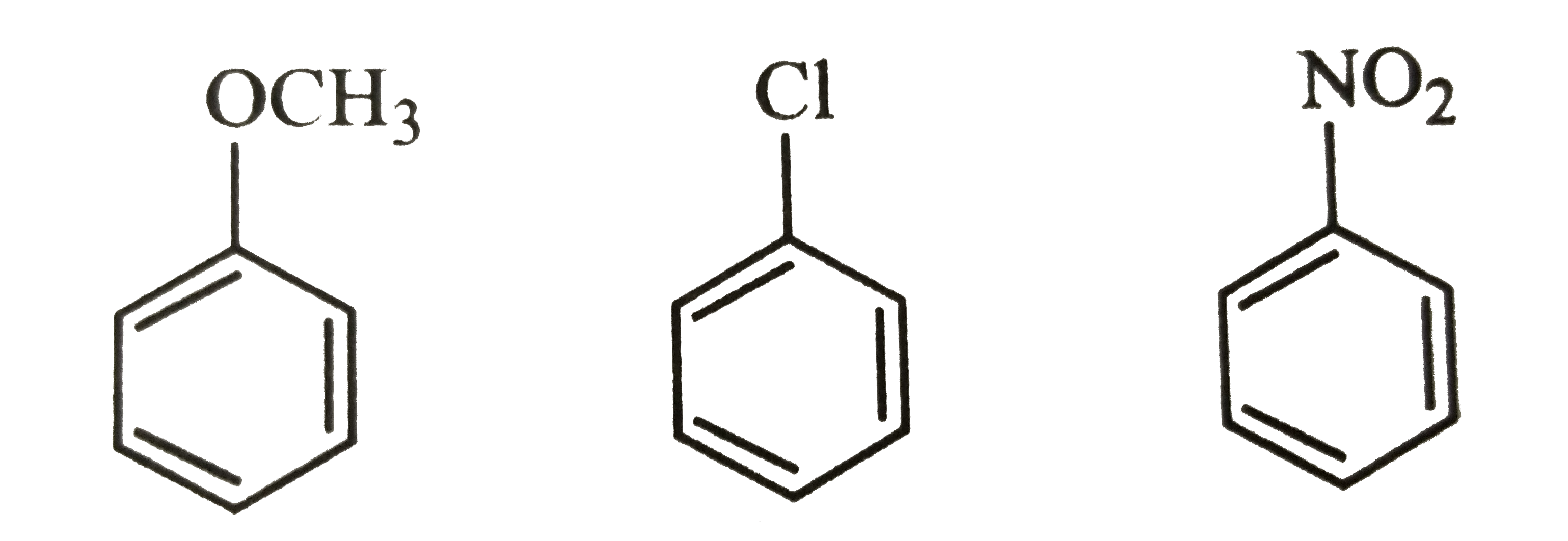Complete Solutions to NCERT EXEMPLAR PROBLEMS WITH ANSWERS, HINTS AND SOLUTIONS (SHORT ANSWER QUESTIONS) of chapter HYDROCARBONS of Class 11 book with complete answers and questions
| Class 11 | CHEMISTRY |
| Chapter | HYDROCARBONS |
| PRADEEP | NCERT EXEMPLAR PROBLEMS WITH ANSWERS, HINTS AND SOLUTIONS (SHORT ANSWER QUESTIONS) |
| Number Of Questions | 20 |
| Academic Year | 2023-24 |
Why do alkenes prefer to undergo electrophilec addition reaction while arenes prefer electrophilic substitution reactions ? Explain.
View SolutionAlkynes on reduction with sodium in liquid ammonia form trans alkenes. Will the butene thus formed on reduction of 2-butyne show the geometrical isomerism ?
View SolutionRotation around carbon-carbon single bond of ethane is not completely free. Justify the statement
View SolutionDraw Newman and sawhorse projections for the eclipsed and staggered conformations of ethane. Which of these conformations is more stable and why ?
View SolutionThe intermediate carbocation formed in the reactions of HI,HBr, and HCl with propene is the same and the bond energy of HCl, HBr, and HI is `430.5 KJ mol^(-1), 363.7 KJ mol^(-1)` and `296.8 KJ mol^(-1)` respectively. What will be the order of reactivity of these halogen acids?
View SolutionWhat will be the product obtained as a result of the following reaction and why ?

View SolutionHow will you convert benzene into:
(i) p-nitrobromobenzene
(ii) m-nitrobromobenzene
View SolutionArrange the following set of compounds in the order of their decreasing relative reactivity with on electrophile . Give reason .

View SolutionDespite their-I effect, halogens are o- and p- directing in haloarenes. Explain .
View SolutionWhy does presence of a nifro group make the benzene ring less reactive in comparison to the unsubstituted benzene ring . Explain .
View SolutionSuggest a route for the preparation of nitrobenzene starting from acetylene ?
View SolutionPredict the major product(s) of the following reactions and explain their formation.
`H_(3)C-CH=CH_(2) underset("HBr")overset(Ph-CO-O_(2)H)to`
`H_(3)C-CH=CH_(2) overset("HBr")to`
View SolutionNucleophiles and electrophiles are reaction intermediates having electron rich and electron deficient centres respectively . Hence, they tend to attack electron deficient and electron rich centres respectively. Classify the following species as electrophiles and uncheophiles.
(i) `H_(3)CO^(-)`
(ii) `H_(3)C-overset(O)overset(||)C-O^(-)`
(iii)Cl
(iv)`Cl_(2)C:`
(v) `(H_(3)C)_(3)C^(+)`
(vi) `Br^(-)`
(vii) `H_(3)COH`
(viii) R-NH-R
View SolutionThe relative reactivity of `1^(@), 2^(@)` and `3^(@)` hybrogen's towards chlorination is `1 : 3.8 : 5`. Calculate the percentages of all monochlorinated products obtained from 2-methylbutane.
View SolutionWrite the structures and names of products obtained in the reactions of sodium with a mixture of 1-iodo-2-methylpropane and 2-iodopropane.
View SolutionWrite hydrocarbon radicals that can be formed as intermediates during monochlorination of 2-methylpropane ? Which of them is more stable? Give reasons.
View SolutionAn alkane `C_(8)H_(18)` is obtained as the only product on subjecting a primary alkyl halide to Wurtz reaction. On monobromination this alkane yields a single isomer of a tertiary bromide. Write the structure of alkane and the tertiary bromide.
View SolutionThe ring systems having following characteristics are aromatic.
(i) Planar ring containing conjugated `pi` bonds .
(ii) complete dolocalisation of the `pi` -electron in ring system i.e. , each atom in the ring has unbybridised p-orbital , and
(iii) Presence of `(4n+2)pi`-electrons in the ring where n is an integer(n = 0, 1, 2, .......) [Huckel rule]. Using this information classify the following compounds as aromatic/non-aromatic.

View SolutionWhich of the following compounds are aromatic according to Huckle's rule ?

View SolutionSuggest a route to prepare ethyl hydrogensulphate `(CH_(3)-CH_(2)-OSO_(2)-OH)` starting from ethanol `(C_(2)H_(5)OH)` .
View Solution
NCERT EXEMPLAR PROBLEMS WITH ANSWERS, HINTS AND SOLUTIONS (SHORT ANSWER QUESTIONS) questions and complete solutions for chapter HYDROCARBONS of PRADEEP CHEMISTRY (HINGLISH) of Class 11
All Exercises from PRADEEP Class 11 CHEMISTRY HYDROCARBONS
- ADDITIONAL QUESTIONS (LONG ANSWER QUESTIONS)
- ADDITIONAL QUESTIONS (SHORT ANSWER QUESTIONS)
- ADDITIONAL QUESTIONS (VERY SHORT ANSWER TYPE QUESTIONS )
- ADVANCED PROBLEMS FOR COMPETITION
- ANALYTICAL QUESTIONS AND PROBLEMS WITH ANSWERS/SOLUTIONS (PROBLEMS)
- ANALYTICAL QUESTIONS AND PROBLEMS WITH ANSWERS/SOLUTIONS (QUESTIONS)
- Competition Focus (JEE(main and advanced)/Medical Entrance) III. MULTIPLE CHOICE
- Competition Focus (JEE(main and advanced)/Medical Entrance) IV. MATCHING TYPE QUESTIONS
- Competition Focus (JEE(main and advanced)/Medical Entrance) V. MATRIX-MATCH TYPE QUESTIONS
- Competition Focus (JEE(main and advanced)/Medical Entrance) VI.INTEGER TYPE QUESTIONS
- Competition Focus (JEE(main and advanced)/Medical Entrance) VII.NUMERICAL VALUE TYPE QUESTIONS
- Competition Focus (JEE(main and advanced)/Medical Entrance) VIII. ASSERTION - REASON TYPE QUESTIONS
- Competition Focus (JEE(main and advanced)/Medical Entrance) I. MULTIPLE CHOICE QUESTIONS
- Competition Focus (JEE(main and advanced)/Medical Entrance) II. MULTIPLE CHOICE
- CONCEPTUAL Questions
- CURIOSITY QUESTIONS
- NCERT EXEMPLAR PROBLEMS WITH ANSWERS, HINTS AND SOLUTIONS (MULTIPLE CHOICE -I)
- NCERT EXEMPLAR PROBLEMS WITH ANSWERS, HINTS AND SOLUTIONS (MULTIPLE CHOICE -II)
- NCERT EXEMPLAR PROBLEMS WITH ANSWERS, HINTS AND SOLUTIONS (ASSERTION AND REASON TYPE QUESTIONS)
- NCERT EXEMPLAR PROBLEMS WITH ANSWERS, HINTS AND SOLUTIONS (LONG ANSWER QUESTIONS )
- NCERT EXEMPLAR PROBLEMS WITH ANSWERS, HINTS AND SOLUTIONS (MATCHING TYPE QUESTIONS)
- NCERT EXEMPLAR PROBLEMS WITH ANSWERS, HINTS AND SOLUTIONS (SHORT ANSWER QUESTIONS)
- NCERT QUESTION AND EXERCISES WITH ANSWERS
- NCERT QUESTION AND EXERCISES WITH ANSWERS (NCERT EXCERCISES)
- PROBLEMS FOR PRACTICE
- SAMPLE PROBLEM
- TEST YOUR GRIP (FILL IN THE BLANKS )
- TEST YOUR GRIP (MULTIPLE CHOICE )